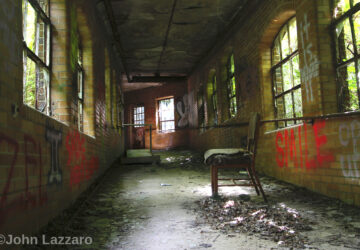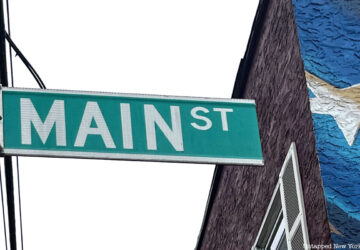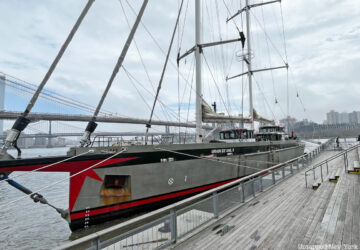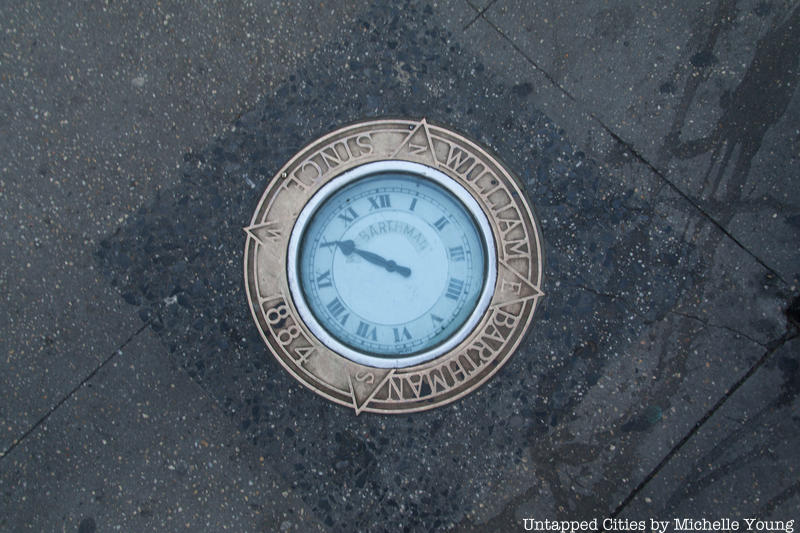In the heart of what is now the Financial District runs a street with a curious name, and an even more interesting past. Known by film buffs as the inspiration for the 1936 crime movie, 15 Maiden Lane, Maiden Lane is so much more than it appears.
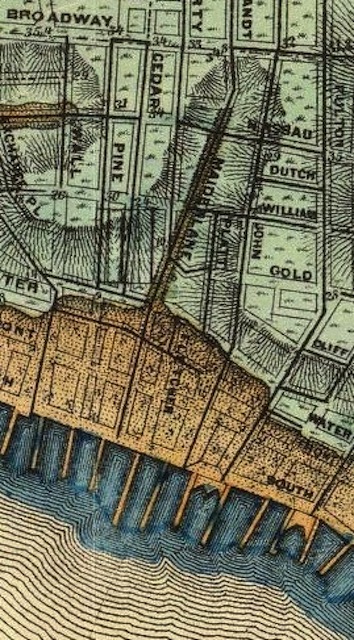 The Vieile map of New Amsterdam, showing the centrally located Maiden Lane. Image cropped from full image on Wikimedia Commons. (You might notice the many slips on the waterfront, given my last article on the subject).
The Vieile map of New Amsterdam, showing the centrally located Maiden Lane. Image cropped from full image on Wikimedia Commons. (You might notice the many slips on the waterfront, given my last article on the subject).
Stretching west from the South Street Seaport all the way to the World Trade Center Site, Maiden Lane now hosts such significant edifices as The Federal Reserve of New York, the Continental Center, the Cushman Building, and the Goldsmiths’ and Silversmiths’ Building, evoking an eclectic mix of modernist, neoclassicist, and beaux arts architecture all along the lane. Also home to several local shops and restaurants, the street fuses the area’s overall impression of business authority with an air of community and an artistic sensibility.
In fact, the recently remodeled Louise Nevelson plaza (near the Wall Street area of the Financial District) was the first public space in New York City to be named after an artist; honoring the “pioneering creativity” of sculptor Louise Nevelson, the triangular space opened in 1977 to coincide with the unveiling of the seven modern steel sculptures that inhabit the plaza.
But Maiden Lane wasn’t always such a lofty venue for commerce and art. One of the first major pathways in colonial New Amsterdam, it was originally named “Maagde Paatje,” Dutch for “Maiden Path”. The WPA Guide to New York City described it as “a footpath used by lovers along a rippling brook;” while in all probability, lovers certainly did carouse along the creek, the pathway was also called “Maiden Lane” because of the popularity of the nearby brook among mothers and daughters as a place to do the family laundry on sunny days. (The humble, everyday origins of NYC’s Maiden Lane are much tamer than those of the infamous alleyway in San Francisco that shares its name; San Francisco’s Maiden Lane was originally called Morton Street, though its current name certainly calls up its historical reputation as having once been the location of the city’s most popular brothels.
After the street was laid and cobbled in 1698, its southern-most end (what would have stretched into Fly Market Slip in the late 1600s/early 1700s) quickly became home to the popular Fly Market a year later, so named thanks to a corruption of the original Dutch word for valley, “vly,” which was often used to describe the natural geography of the area. The Fly Market offered fresh produce, fish, and meat under a covered roof, and while it lived to become New York’s longest running market, by 1815, city residents requested that it be disbanded and demolished due to its increasingly filthy and inconvenient state. By 1823, the market had closed for good, giving itself over to the newer Fulton Street Market, which survives today as the New Amsterdam Market.
During the 1712 slave revolt, twenty three black and Native American slaves escaped from the slave market on Wall Street, then killed nine people and set fire to a building on Maiden Lane.
Throughout the 18th century, Maiden Lane saw plenty of action. On April 6, 1712, New York’s first slave revolt took place on Maiden Lane thanks to goings-on at a nearby slave market near Wall Street and the East River. In September 1732, the birthplace of professional theatre in New York came into being when a group of actors set up house in an upstairs room of a building at the corner of Maiden Lane and Pearl Street that they had fitted with a stage; the company ran regular shows out of this “theater,” known as The Play House, until its closing two years later, in 1734. During the latter half of the century, New York City was the capitol of the newly independent United States of America, and as such was home to many of the founding fathers, including Thomas Jefferson, who briefly lived on Maiden Lane.
In the 19th and 20th centuries, the newly gas-lit street became much more renowned for its shopping than for anything else. The area saw a series of major renovations, starting with the infilling of Fly Market Slip at the base of Maiden Lane. Newer, more elaborate styles of architecture called for the addition of cast-iron storefronts. (One of these storefronts is still in existence today, at 90-94 Maiden Lane).
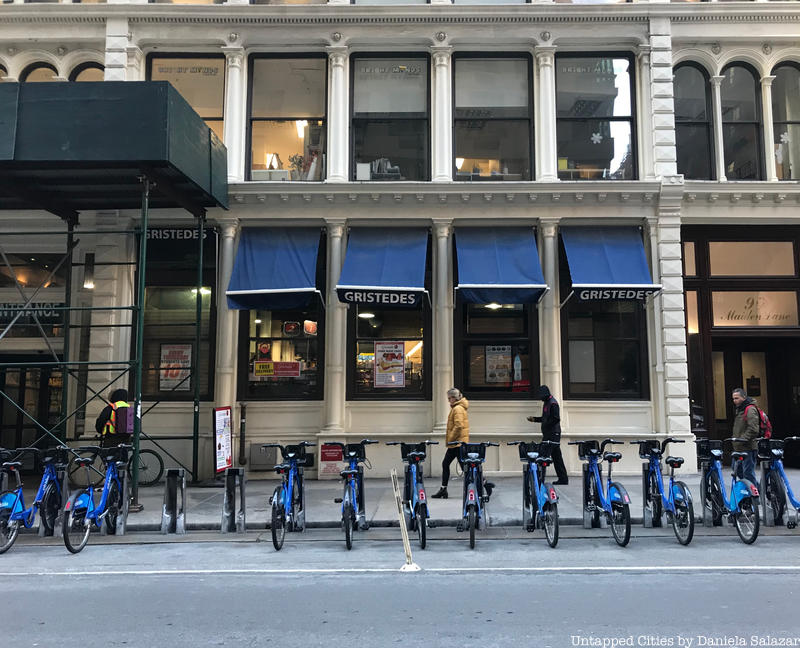 Currently sprucing up a Gristedes supermarket, the cast iron facade at 90-94 Maiden Lane is the last remnant of a common style of architectural remodeling that was popular on Maiden Lane during the 19th century. Designed by Charles Wright, this particular facade first decorated the ever-changing family business started in 1810 by James Roosevelt (one of Theo and Frank’s enterprising ancestors).
Currently sprucing up a Gristedes supermarket, the cast iron facade at 90-94 Maiden Lane is the last remnant of a common style of architectural remodeling that was popular on Maiden Lane during the 19th century. Designed by Charles Wright, this particular facade first decorated the ever-changing family business started in 1810 by James Roosevelt (one of Theo and Frank’s enterprising ancestors).
A skylit block of forty shops called the New York Arcade was erected in 1827, in the hopes that this beautiful shopper’s paradise would see the same kind of success that its inspiration, the Burlington Arcade, had garnered in London. Sadly, while the New York Arcade was a sight to behold, all delicate glass panes and high, arched ceilings, it was a financial disaster, and the private investors who had originally constructed it had it torn down only a few years later.
Still, though the New York Arcade was a failure, Maiden Lane itself remained a bustling center for shopping throughout the 20th century, especially for precious metals and stones; by the middle of the 1900s, it was well-known as the Jewelry District, which has since relocated to the area near West 47th Street. Many of the most prominent American jewelers and clockmakers of the time first set up shop on Maiden Lane, including William Barthman Jewellers, whose bronze and glass clock still tells the correct time to this day from where it lies embedded in the sidewalk, at the street’s Broadway intersection
 According to a 1946 report issued by the NYPD, approximately 51,000 people walk on the original William Barthman Jewellers clock every weekday between 11:00 AM and 2:00 PM.
According to a 1946 report issued by the NYPD, approximately 51,000 people walk on the original William Barthman Jewellers clock every weekday between 11:00 AM and 2:00 PM.
Today, the street links past to present, commerce to community, and remains a prominent standby of New York’s fascinating history as one of the oldest cities in the U.S. So the next time you’re in the financial district, take a stroll down this old lovers’ lane, and really feel the lifeblood of New York City in its worn down stones. Take in the the view of the waterfront, and perhaps conjure up a less civilized time, when the burning of buildings usually meant slave revolts or revolutionary battles. Or, if you’re hoping for a more peaceful exploration of Maiden Lane, you could envision stylish couples searching for engagement rings here close to the turn of the century. Either way, Maiden Lane still has plenty to offer the casual observer of life in NYC.

